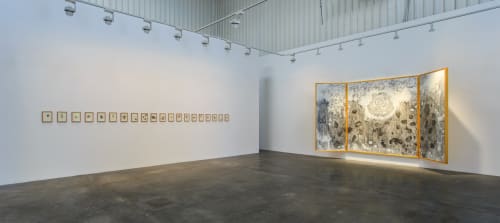To coincide with Art Week 2015, Lawrie Shabibi is delighted to welcome back Nadia Kaabi-Linke for her second solo exhibition with the gallery.
Fresh from a run of international shows including No Frills at Cristina Guerra Contemporary in Lisbon, Portugal, and her London debut with The Mosaic Rooms last October, this exhibition will bring together eight artworks that demonstrate the breath of Kaabi-Linke's practice and preoccupations with modern myths of macho culture and masculinity. 'Fahrenheit311' refers to the melting point of the steroid hormone testosterone, associated with 'manly' characteristics and behavioural patterns. These manifest themselves in the show through themes such as war and heroism, the exploitation of the environment, elitism, violence, heroism, exploitation, pride and ignorance - making connections to the seven deadly sins.
Kaabi-Linke has built up a strong body of work over recent years, preoccupied with places and their histories. Making use of many different media, codifications, contexts and routine structures of daily life, her practice is always questioning, evocative and highly thought provoking.
The central work in the exhibition is Altarpiece (2015). Reminiscent in its form of a religious triptych and coated in gold leaf, the content of the three panels are prints Kaabi-Linke has taken of the bullet-holed exterior of a building in central Berlin, which has numerous historical associations. It was a former bunker of the German Reich Railway built by forced labour to shelter civilians during World War II, used as a textile warehouse by the Red Army during the Cold War, a store for fruits when it was called 'the banana bunker' and later re-appropriated for techno parties and art exhibitions. Restructured, today it holds artworks of the Boros Collection.
Referencing the history of a real object (the bunker) as well as the object of history (the representation of past events), The Altarpiece becomes a metaphor for the eternal conservation of vanishing historical traces. By creating a link between the wounds inflicted on buildings during war and religious subjects depicted in traditional, Christian altarpieces such as the stigmata of the Messiah, when open The Altarpiece reveals some dark spots of German history. But the doors can be closed, just as cultural and political strategies are to cover-up the past and create new facades on buildings, and we are left with beautiful, golden object or golden square - a familiar symbol of stabilityand wealth in Germany.
Other works in the exhibition will include Tunisian Americans (2012), a wall installation of 400 tiny flacons (small bottles in which kohl is sold) containing soil from 400 US military graves in Tunisia, Impunities London Originals (2012) documenting traces of domestic violence; A Short History of Salt and Sun (2013) wall prints signifying the decay and failure of the Tunisian tourism industry and three related works from 2015 Grindballs, Hardballs and Bangballs which comment on sexual dominance, exploitationof the environment, construction and warfare and being under pressure.

